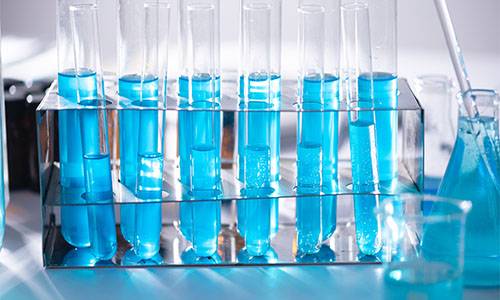

Melamine, commonly known as dense amine, protein essence, molecular formula C3H6N6, IUPAC named as “1,3,5-triazine-2,4,6-triamine”, is a triazine nitrogenous heterocyclic organic compounds, used as chemical raw materials.
It is a white monoclinic crystal, almost tasteless, slightly soluble in water (3.1g/L room temperature), soluble in methanol, formaldehyde, acetic acid, hot ethylene glycol, glycerol, pyridine, etc., insoluble in acetone, ether, harmful to health, and not to be used in food processing or food additives.
On October 27, 2017, the World Health Organization’s International Agency for Research on Cancer published a preliminary list of carcinogens for reference, melamine in the list of carcinogens in category 2B.
1.Physical properties
Appearance and properties: white monoclinic crystals.
Melting point: 354℃
Density: 1.661g/cm3
Solubility: insoluble in water, slightly soluble in ethylene glycol, glycerol, ethanol, insoluble in ether, benzene, carbon tetrachloride.
Chemical properties
Non-combustible, stable at room temperature. The aqueous solution is weakly alkaline (pH=8), and can form melamine salt with hydrochloric acid, sulfuric acid, nitric acid, acetic acid, oxalic acid, etc.
Under neutral or slightly alkaline conditions, it condenses with formaldehyde to form various hydroxymethyl melamine, but under slightly acidic conditions (pH=5.5~6.5), it condenses with derivatives of hydroxymethyl to produce resin.
When hydrolyzed by strong acid or strong alkali aqueous solution, the amine group is gradually replaced by a hydroxyl group, and Mr. melamine is formed into melamine diamide, which is further hydrolyzed to produce melamine monoamide and finally melamine acid.
2. Production method
It is obtained by reacting dicyandiamide with ammonia in methanol solvent at 392°F. This method consumes 1180kg of dicyandiamide (98%) and 30kg of liquid ammonia per ton of product. compared with this method, the area method is less costly and more often used.
Urea is reacted by boiling at 716-752°F with ammonia as the carrier and silica gel as the catalyst, which first decomposes to produce cyanuric acid and further condenses to produce melamine.
The generated melamine gas is cooled and trapped to obtain the crude product, which is then dissolved, impurities are removed and the finished product is recrystallized. The production of melamine by urea method consumes about 3800kg of urea and 500kg of liquid ammonia per ton of product.
3. Market Development
Melamine uses urea as raw material, and it takes about 3 tons of urea to produce 1 ton of melamine.
China is the world’s largest producer of urea, with large urea production and low prices. Even with the high tariff imposed by the state to curb urea export, the annual urea export volume still reaches (3-7) million tons, and the abundant urea resources make China’s melamine production a unique advantage.
The serious expansion of melamine production capacity in China has led to fierce competition among Chinese melamine enterprises and a weak price increase in the industry.
4. Main Applications
Melamine resin can be made by condensation polymerization with formaldehyde, which can be used in the plastic and coating industry, and also can be used as an anti-folding and anti-shrinking treatment agent for textile. Its modified resin can be used for bright color, durability, and good hardness of metal coatings.
It can also be used as a strong, heat-resistant decorative sheet, moisture-proof paper, and gray leather tanning agent, adhesive for synthetic fireproof laminate, fixing agent or hardener for water repellent, etc.
582 melamine resin made from melamine, formaldehyde, and butanol. It is used as a leveling agent for solvent-based polyurethane coatings and is particularly effective.
It is the main raw material of melamine-formaldehyde resin, used as a reagent for organic element analysis, and also used in the synthesis of organic and resin as a tanning agent and filler for leather processing.
It can be used in the plastic and coating industry, and also used as an anti-folding and anti-shrinking treatment agent for textile. Its modified resin can be used for bright color, durability, and good hardness of metal coatings.
Melamine resin made by condensation polymerization with formaldehyde is widely used in the manufacture and processing of wooden building formwork. It can be used for waterproofing of the formwork surface and adhesion of wood core board to increase the reuse times of formwork.
Melamine is widely used in gardening, tableware, wood, plastic, paint, paper, textile, leather, electrical, pharmaceutical, and other industries.
5. Terminology application
Safety terminology
S36/37:Wear suitable protective clothing and gloves.
Wear suitable protective clothing and gloves.
Risk terminology
R20/21: Harmful by inhalation and in contact with skin.
Harmful by inhalation and in contact with skin.
R44:Risk of explosion if heated under confinement.
Risk of explosion if heated under confinement.
RunSun Houseware design
As a global leader in Houseware, RunSun provides more than 2500 Houseware designs for Europe, America, and Australia.
Contact RunSun
Email: [email protected]
WeChat/Whatsapp: (+86)13246751686
Phone: +86 13246751686
Website:https://www.runsun-trans.com/

